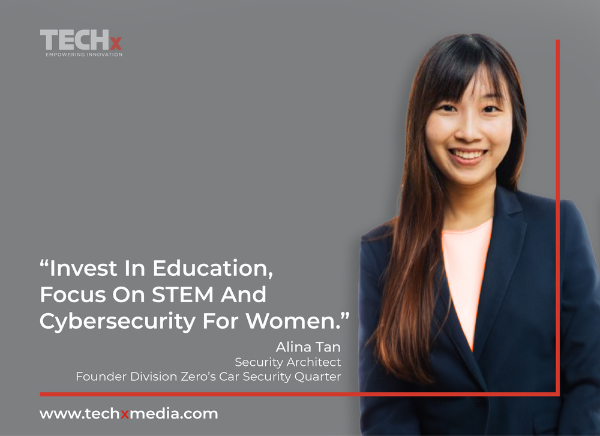
Meet Alina Tan, a trailblazer in automotive cybersecurity and a leading advocate for women in the field. With a passion for car racing and a knack for ethical hacking, Alina combines her expertise to safeguard the future of transportation. Learn how she’s breaking barriers and inspiring the next generation of cybersecurity professionals.
1. How did your journey in cybersecurity intersect with the automotive industry, and when did you decide to pursue a career in this field?
From a young age, my passion for car racing and tinkering with vehicles coincided with an early interest in computer gaming. It was my encounter with malware during this time that sparked my curiosity about cybersecurity. Recognizing the overlap between my interests in vehicle racing and cybersecurity, I founded a specialized interest group focused on automotive security in Singapore. This initiative aims to bring together cybersecurity enthusiasts, professionals, and students to collaborate on research and exploration in automotive cybersecurity.
2. What are the primary risks and vulnerabilities you’re addressing in the automotive industry to ensure user safety?
As the automotive industry moves towards Autonomous and Electric vehicles with the adoption of Fleet Management Systems (FMS) and Charging Management Systems (CMS), new risks and vulnerabilities emerge. In addition to vulnerability research and security testing, we assist companies in developing comprehensive policies and standards, including security controls to fortify FMS and CMS systems.
3. Which technologies do you believe will be crucial for automotive cybersecurity in the next 5 years?
Several technologies will play pivotal roles in automotive cybersecurity:
– Intrusion Detection Prevention Systems (IDPS) and the establishment of Vehicle Security Operations Centers (VSOCs) for continuous monitoring of in-vehicle networks.
– Secure Over-The-Air (OTA) updates to ensure safe delivery of software patches and updates to vehicles.
– Utilization of blockchain technology for tamper-proof record-keeping and ensuring data integrity.
4. What lessons have you learned as a woman and an ethical hacker in the cybersecurity industry?
As a woman in cybersecurity, I’ve learned the importance of being a trailblazer and seeking support when needed. Collaboration, perseverance, and resilience are key to navigating challenges in this field.
5. What barriers do young women face in pursuing careers as ethical hackers?
Young women often lack support, recognition, and inclusive opportunities in the cybersecurity industry. Imposter syndrome can also deter them from exploring opportunities in ethical hacking.
6. How can enterprises and governments create more opportunities for women in cybersecurity?
Investments in education, training, mentorship, and recognition programs are essential. Providing financial support, internships, and networking opportunities for women-owned cybersecurity businesses can also foster inclusivity.
7. You were recognized as one of the Top 30 women in Security in ASEAN. How do you encourage more women to join the field?
I aim to inspire and empower other women through mentorship, representation, and advocacy. By sharing my experiences and accomplishments, I hope to demonstrate that women can excel in cybersecurity.
8. What are your views on the growth of women’s participation and leadership in the cybersecurity industry in Asia and the Middle East?
It’s encouraging to see more women in leadership roles and initiatives dedicated to showcasing their talents. I believe we can build a stronger cybersecurity community by fostering diversity and inclusion.
9. What are your expectations for stepping onto the stage of GISEC Global for the first time this April?
I’m excited to present our research and engage with professionals globally. Networking with industry experts presents an opportunity to contribute to cybersecurity knowledge and practice on a global scale.